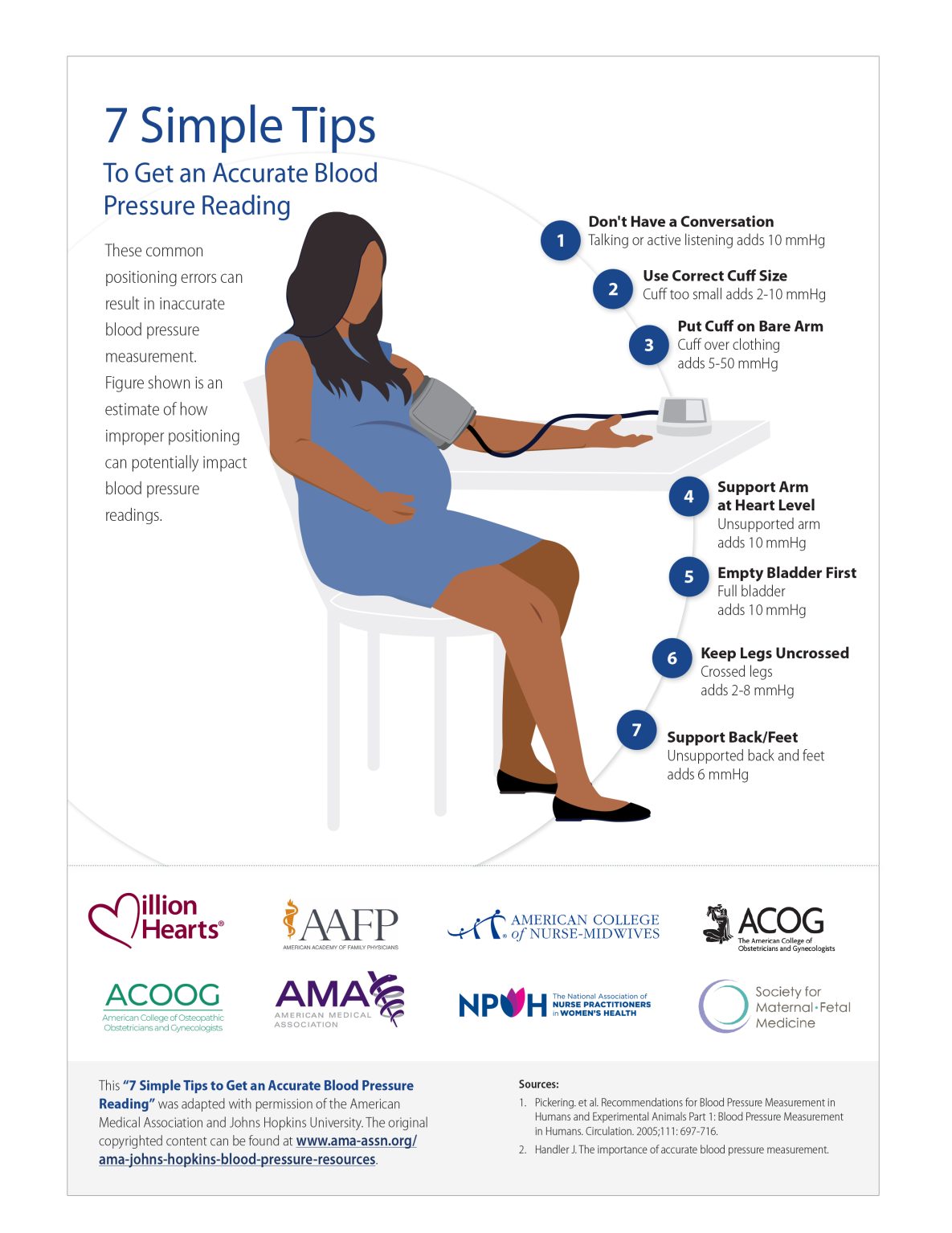Hypertensive Disorders of Pregnancy
Hypertensive disorders of pregnancy are a leading cause of maternal mortality and can put both mother and baby at risk for problems during pregnancy.1 High blood pressure can also cause problems during and after delivery. Importantly, hypertensive disorders of pregnancy are often preventable and treatable. In the U.S., high blood pressure is noted in one in every 12 to 17 pregnancies among women aged 20 to 44.2
Hypertensive disorders of pregnancy have become more common, affecting approximately 15% of women during their reproductive years, in part as a result of advanced age at first pregnancy, as well as increasing prevalence of obesity and other cardiometabolic risk factors.1,3 There are racial/ethnic disparities in both the burden and outcomes of hypertensive disorders of pregnancy.1
| Condition | Description |
|---|---|
| Chronic Hypertension | Chronic hypertension is high blood pressure present before pregnancy or diagnosed before 20 weeks of pregnancy. Women who have chronic hypertension can also develop preeclampsia |
| Gestational Hypertension | Gestational hypertension is high blood pressure that develops at or after 20 weeks of pregnancy without evidence of protein in the urine or other heart or kidney problems. Gestational hypertension usually improves after delivery. However, some women with gestational hypertension have a higher risk of developing chronic hypertension in the future. |
| Preeclampsia | Preeclampsia occurs when a woman with previously normal blood pressure suddenly develops high blood pressure and protein in the urine or other problems (e.g., low platelet count, impaired liver function) after 20 weeks of pregnancy. Women who have chronic hypertension can also develop preeclampsia. Preeclampsia occurs in about 1 in 25 pregnancies in the U.S. |
| Eclampsia | Some women with preeclampsia can develop seizures. This is called eclampsia, which is a medical emergency. |
| Hemolysis Elevated Liver Enzymes and Low Platelet Count (HELLP) Syndrome | HELLP syndrome is life-threatening condition that can occur during pregnancy or soon after delivery. It can cause high blood pressure and seizures, and can lead to a potentially fatal liver disorder or stroke if left untreated. |
Prevention of Hypertensive Disorders of Pregnancy
Lifestyle and behavioral interventions, including optimal maternal weight gain and diet, can improve pregnancy outcomes. Exercise may reduce gestational hypertension and preeclampsia risk by 30% to 40%. Low-dose aspirin started between 12 to 16 weeks of pregnancy can reduce the risk of preeclampsia and related adverse outcomes by 10% to 20% in women at increased risk.1 Accurate blood pressure measurement is important for diagnosing, classifying, and treating hypertensive disorders of pregnancy. Several self-measured blood pressure devices are accurate in pregnant women, including those with gestational hypertension and preeclampsia.4
Treatment
Additional evidence is needed to better define optimal treatment targets and the threshold for pharmacotherapy for hypertensive disorders of pregnancy. Antihypertensive therapy in the setting of hypertensive disorders of pregnancy should focus on the use of safe and effective medications specific to this population. Treatment of hypertension, prevention of seizures, and timed delivery are currently the primary approaches for women with preeclampsia.1
Importance of Longitudinal Care
Hypertensive disorders of pregnancy can lead to complications during and after delivery as well as life-long risk and early onset of CVD. Therefore, postpartum assessment and control of cardiovascular risk factors is essential in those with hypertensive disorders of pregnancy. A team-based approach and multi-specialty collaboration is needed to ensure appropriate care transition with the goal of optimizing cardiovascular preventive strategies across the life course.1
Hypertension in Pregnancy: Alicia’s Story
Watch the video below to hear Alicia’s story as she provides a first-hand look into the importance of addressing hypertension in pregnancy.
Tools and Resources
For Clinicians
- Oscillometric Blood Pressure Devices Validated for Accuracy During Pregnancy [PDF – 441 KB]
This table from a 2021 Current Atherosclerosis Reports journal article features oscillometric blood pressure devices validated for accuracy during pregnancy. - Promoting Risk Identification and Reduction of Cardiovascular Disease in Women Through Collaboration With Obstetricians and Gynecologists: A Presidential Advisory From the American Heart Association and the American College of Obstetricians and Gynecologists
This AHA/ACOG presidential advisory provides a set of principles for coordinated health care delivery among OB/GYNs and cardiologists to guide the identification and prevention of cardiovascular disease in women. - Hypertension in Women Across the Lifespan
This review highlights the biological processes across a woman’s lifespan from young adulthood through menopause and beyond that affect blood pressure and summarizes women’s representation in hypertension clinical trials. - Historical and Recent Changes in Maternal Mortality Due to Hypertensive Disorders in the United States, 1979 to 2018
This study evaluates the contributions of maternal age, year of the mother’s death, and year of the child’s birth on trends in hypertension-related maternal deaths in the United States.
Key Publications
- Hypertension in Pregnancy
This report from the American College of Obstetricians and Gynecologists Task Force on Hypertension in Pregnancy provides evidence-based recommendations for the management of patients with hypertension during and after pregnancy. - Screening for Preeclampsia: US Preventive Services Task Force Recommendation Statement
This USPSTF statement recommends screening for preeclampsia in pregnant women with blood pressure measurements throughout pregnancy. - Epidemiology of Pre-eclampsia and the Other Hypertensive Disorders of Pregnancy
This review outlines the disease definitions, global burden of disease, natural history, and unresolved epidemiologic questions of the hypertensive disorders of pregnancy. - Hypertensive Disorders and Pregnancy-Related Stroke Frequency, Trends, Risk Factors, and Outcomes
This study evaluated the trends and associations of hypertensive disorders of pregnancy with stroke risk. - Antiplatelet Agents for Preventing Pre‐eclampsia and its Complications
This Cochrane systematic review found that antiplatelet agents, largely low‐dose aspirin, have moderate benefits when used for prevention of preeclampsia and its consequences.

